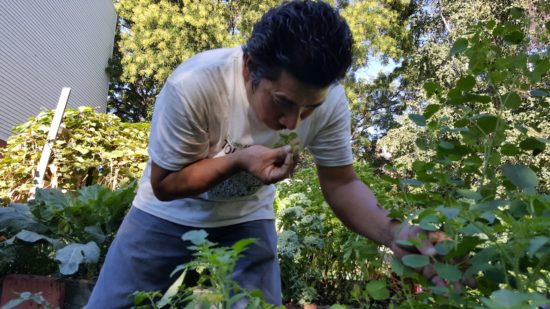
When Nayeli Leon turned 7 a few weeks ago, she celebrated in a purple tulle princess dress, surrounded by her parents, cousins, uncles and aunts beneath the trees of Brook Park in Mott Haven. Adults sat at a picnic table right next to the feast: mole sauce brought straight from Mexico, rice, chicken, pasta and tacos. As children played, Nayeli’s father, Faustino, activated an electricity generator so they could play music and use a microphone.
More than a place to party, the 33,000-square-foot community park at Brook Avenue and 141st Street is a place where the family works together. Faustino, 45, has volunteered there almost every day for the last year. He made new radish, pepper, kale and tomato beds, filled them with soil, sowed seeds, shaped bushes, buried pipes, fixed fences. His wife, Carmela Herrera, 36, takes care of the sunflowers, dahlias and hibiscus.
“I leave all my stress here,” said Faustino, a recovering alcoholic, smiling shyly. “I relax because, doing the work, I forget the problems and because, talking to people, I can release many things and go forward.” He has been working in a liquor store for 18 years, almost since he immigrated from Acapulco, Mexico, to New York, where he and his wife raised four children.
In a 2014 study by the New York Academy of Medicine, 8 to 9 percent of South Bronx residents reported experiencing serious psychological distress, compared to 5.5 percent in New York City overall. The research points out that it is more stressful to deal with the challenges of low income in the area, and immigrant populations face additional stressors such as insurance and language.
Recent research highlights the mental health benefits the Leon family experiences in the garden. One theory is that nature does not require focused attention, says Peter James from Harvard Medical School. Scientists also point out that green spaces create a positive environment for developing strong social relations and avoiding loneliness, a major trigger of mental and physical illness.
A 2016 study by James and his colleagues associated proximity to vegetation with lower risk of mortality from cancer and respiratory diseases. Researchers concluded that reduced stress, which improves mental health, could account for 30 percent of the benefits. Other research in the U.S. and Europe shows that green spaces benefit less affluent people more than wealthy ones.
Activists often complain about the South Bronx’s lack of green areas. A report by New Yorkers for Parks, an independent organization, points out that Mott Haven has only 1.1 acres of open space per 1,000 residents — less than half the average of 2.5 acres per 1,000 residents across the city. Brook Park was created about 20 years ago by community effort in an abandoned area where people used drugs and held dog fights.
Lucy Robson, director of research and planning at New Yorkers for Parks, notes that few parks enjoy the kind of community support Brook Park offers local residents. “Many of the parks in Mott Haven are outdated, under-advocated, and over-concreted,” she said.
Three blocks from Brook Park, on Morris Avenue, Shirley Williams, 71, was hurrying to pick up her great-grandson Jordan, 6, from school. They often go to parks, but she says the area needs more. “A lot of buildings are coming up in this area,” she said, “and kids need some place to go and enjoy themselves.”
The Parks Department is building two parks in the area: the one-acre Melrose Commons Park, expected to be completed by 2019, and a 2.3-acre park on the waterfront from 144th Street to 146th Street, for which the city is still acquiring land.
On a recent Sunday afternoon, Faustino Leon rested on a bench next to the flowers his wife had planted. It was about 3 p.m., and he had worked since the morning cleaning up the area, watering newly sowed papalos, a seasoning herb, and cutting down dry sunflower stalks with a machete. He says resting in the park is much more enjoyable than watching TV indoors.
“When you have a place to relax, you talk to God or to yourself with an open heart and forget everything,” he says. “If you keep your pain locked in, in your room, you have no way out.”
